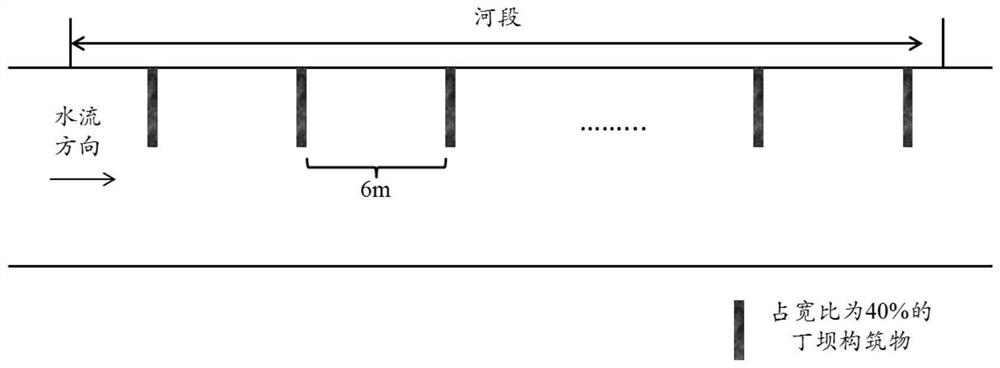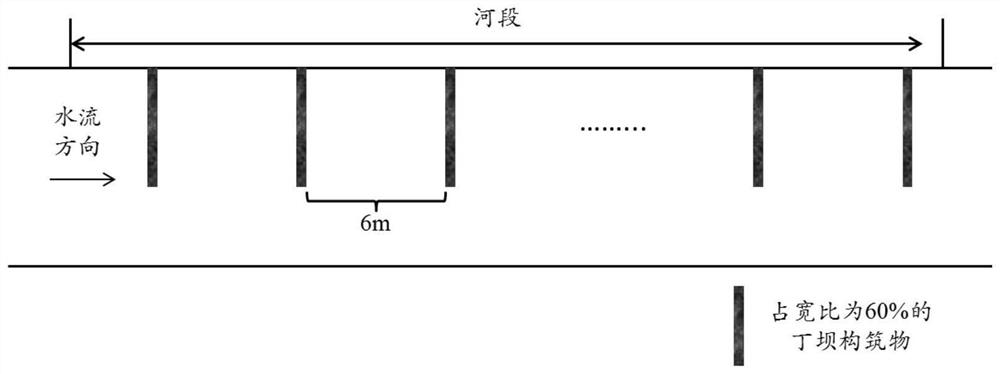Regulation and control method for improving retention potential of nutritive salt in stream ditch
A nutrient salt and stream technology, which is applied in the field of regulation to improve the retention potential of nutrient salt in streams and ditches, can solve problems such as the reduction of water body self-purification ability, and achieve the effects of convenient implementation, prolonging hydraulic retention time, and easy calculation and determination
- Summary
- Abstract
- Description
- Claims
- Application Information
AI Technical Summary
Problems solved by technology
Method used
Image
Examples
Embodiment 1
[0022] A control method for improving the retention potential of nutrient salts in stream ditches, comprising the following steps:
[0023] (1) Mix hollow bricks with a particle size range of 5cm-10cm, a fineness modulus of 3.1-3.7, and coarse sand and soil with an average particle size of more than 0.5mm according to a mass ratio of 1:1:8. The spur dam structure is made by putting it into a nylon bag, and the soil is a layer of loose material on the surface, which is composed of various granular minerals, organic matter, water, etc. Among them, the organic matter content accounts for 1.5% of the dry weight of the soil, and the humus accounts for organic matter. 82.1% of the total.
[0024] (2) The above-mentioned spur dike structure is arranged on one side of the stream to set a plurality of laying sections with an interval of 6m, and the laying section width is 30cm, the height is 10cm above the water surface, and the length is 40% of the stream width.
Embodiment 2
[0026] A control method for improving the retention potential of nutrient salts in stream ditches, comprising the following steps:
[0027] (1) Mix hollow bricks with a particle size range of 5cm-10cm, a fineness modulus of 3.1-3.7, and coarse sand and soil with an average particle size of more than 0.5mm according to a mass ratio of 1:1:8. The spur dam structure is made by putting it into a nylon bag, and the soil is a layer of loose material on the surface, which is composed of various granular minerals, organic matter, water, etc. Among them, the organic matter content accounts for 1.5% of the dry weight of the soil, and the humus accounts for organic matter. 82.1% of the total.
[0028] (2) The above-mentioned spur dam structure is arranged on one side of the stream to set a plurality of laying sections at intervals of 6m, and the laying section width is 30cm, the height is 10cm above the water surface, and the length is 60% of the stream width.
Embodiment 3
[0030] A control method for improving the retention potential of nutrient salts in stream ditches, comprising the following steps:
[0031] (1) Mix hollow bricks with a particle size range of 5cm-10cm, a fineness modulus of 3.1-3.7, and coarse sand and soil with an average particle size of more than 0.5mm according to a mass ratio of 1:1:8. The spur dam structure is made by putting it into a nylon bag, and the soil is a layer of loose material on the surface, which is composed of various granular minerals, organic matter, water, etc. Among them, the organic matter content accounts for 1.5% of the dry weight of the soil, and the humus accounts for organic matter. 82.1% of the total.
[0032] (2) The above-mentioned spur dike structures are arranged on one side of the stream to set a plurality of placement sections with an interval of 6m, and the width of the placement sections is 30cm, and the height is 10cm above the water surface. The lengths of two adjacent placement section...
PUM
| Property | Measurement | Unit |
|---|---|---|
| Particle size | aaaaa | aaaaa |
| Particle size | aaaaa | aaaaa |
Abstract
Description
Claims
Application Information
 Login to View More
Login to View More - R&D
- Intellectual Property
- Life Sciences
- Materials
- Tech Scout
- Unparalleled Data Quality
- Higher Quality Content
- 60% Fewer Hallucinations
Browse by: Latest US Patents, China's latest patents, Technical Efficacy Thesaurus, Application Domain, Technology Topic, Popular Technical Reports.
© 2025 PatSnap. All rights reserved.Legal|Privacy policy|Modern Slavery Act Transparency Statement|Sitemap|About US| Contact US: help@patsnap.com



